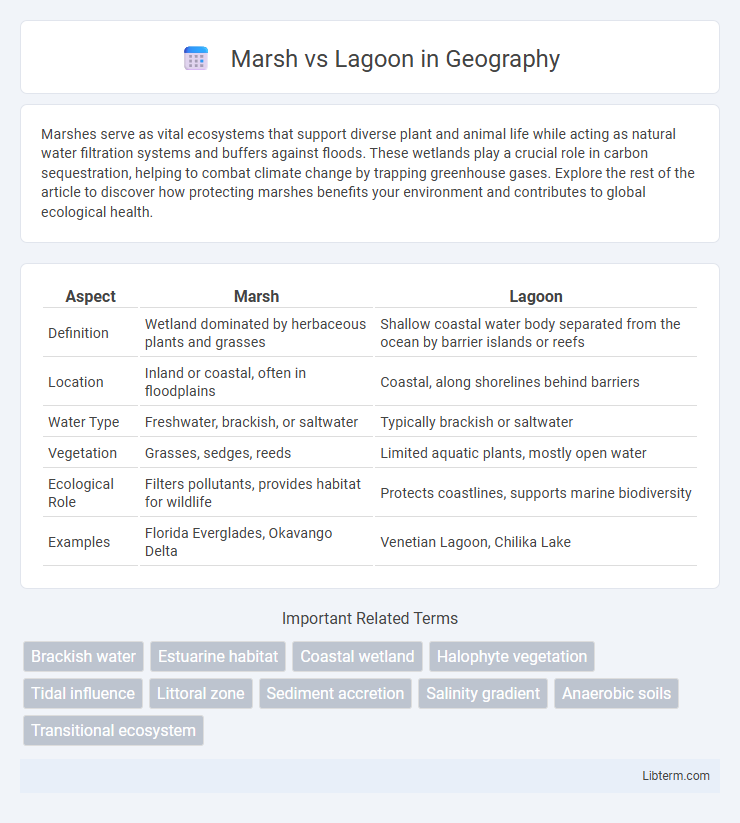Marshes serve as vital ecosystems that support diverse plant and animal life while acting as natural water filtration systems and buffers against floods. These wetlands play a crucial role in carbon sequestration, helping to combat climate change by trapping greenhouse gases. Explore the rest of the article to discover how protecting marshes benefits your environment and contributes to global ecological health.
Table of Comparison
| Aspect | Marsh | Lagoon |
|---|---|---|
| Definition | Wetland dominated by herbaceous plants and grasses | Shallow coastal water body separated from the ocean by barrier islands or reefs |
| Location | Inland or coastal, often in floodplains | Coastal, along shorelines behind barriers |
| Water Type | Freshwater, brackish, or saltwater | Typically brackish or saltwater |
| Vegetation | Grasses, sedges, reeds | Limited aquatic plants, mostly open water |
| Ecological Role | Filters pollutants, provides habitat for wildlife | Protects coastlines, supports marine biodiversity |
| Examples | Florida Everglades, Okavango Delta | Venetian Lagoon, Chilika Lake |
Introduction to Marshes and Lagoons
Marshes are wetland ecosystems characterized by herbaceous plants and saturated soils, often found at the edges of lakes and rivers, providing critical habitats for diverse wildlife. Lagoons are shallow coastal bodies of saline or brackish water separated from the ocean by barrier islands or reefs, supporting unique marine biodiversity. Both marshes and lagoons play essential roles in water filtration, flood control, and carbon storage, highlighting their ecological importance.
Defining Marsh: Characteristics and Types
A marsh is a type of wetland characterized by waterlogged soils, abundant herbaceous plants like cattails and sedges, and a high level of biodiversity. Common types include tidal marshes found along coastlines with fluctuating saltwater levels and freshwater marshes inland with stable freshwater conditions. These ecosystems provide crucial habitat for wildlife, support nutrient cycling, and act as natural water filters.
Understanding Lagoons: Formation and Features
Lagoons are shallow coastal bodies of water separated from larger seas by barrier islands, coral reefs, or sandbanks, forming unique ecosystems with distinct salinity and biodiversity. These water bodies develop through sediment deposition and gradual landform changes, creating habitats that support diverse flora and fauna adapted to brackish conditions. Unlike marshes, lagoons feature open water environments with clearer separation from terrestrial wetlands, emphasizing their importance in coastal landscape dynamics and marine life habitats.
Key Differences Between Marshes and Lagoons
Marshes are coastal wetlands dominated by herbaceous plants and characterized by shallow, slow-moving water with high nutrient levels, while lagoons are shallow coastal bodies of water separated from the ocean by barrier islands or reefs with varying salinity. Marshes support diverse ecosystems with abundant vegetation that filters water and provides habitat for wildlife, whereas lagoons often have brackish water influenced by tidal flows and serve as nurseries for fish and other marine species. The primary difference lies in their hydrology and ecological roles: marshes are primarily freshwater or brackish wetlands, whereas lagoons are semi-enclosed saltwater bodies connected to the ocean.
Ecological Roles of Marshes
Marshes play a crucial ecological role as highly productive wetlands that support diverse plant and animal species, acting as natural filters by trapping pollutants and sediments from water before it reaches larger bodies like lagoons. They provide essential habitat for migratory birds, fish nurseries, and invertebrates, contributing to biodiversity and ecosystem resilience. Unlike lagoons, which are primarily open water bodies often influenced by tidal action, marshes function as interface zones that stabilize shorelines, mitigate flooding, and sequester carbon through dense vegetation.
Biodiversity in Lagoon Ecosystems
Lagoon ecosystems exhibit exceptional biodiversity, supporting diverse species of fish, mollusks, crustaceans, and aquatic plants due to their unique blend of freshwater and marine influences. Unlike marshes, lagoons provide critical nursery habitats for commercially important fish and bird populations, facilitating complex food webs and ecological interactions. The varying salinity gradients and sheltered waters of lagoons foster high species richness and promote genetic diversity vital for ecosystem resilience and productivity.
Hydrology: Water Sources and Salinity Comparison
Marshes receive freshwater primarily from precipitation, surface runoff, and groundwater, resulting in low salinity levels that support diverse plant and animal life adapted to brackish or freshwater environments. Lagoons, often coastal and connected to the ocean, experience a mix of freshwater inflow and saltwater intrusion due to tidal exchange, leading to variable salinity gradients that influence their distinct ecological dynamics. The hydrological differences between marshes and lagoons significantly affect sediment deposition, nutrient cycling, and habitat characteristics within these wetland systems.
Human Impact and Conservation Efforts
Marshes are highly sensitive to human impact, as urban development, pollution, and agriculture often lead to habitat degradation and loss of biodiversity. Conservation efforts for marshes focus on wetland restoration, water quality improvement, and the protection of native species through policies like the Ramsar Convention. Lagoons face similar threats from coastal encroachment, nutrient runoff, and climate change, prompting conservation strategies such as habitat preservation, pollution control, and sustainable fisheries management to maintain ecological balance.
Economic and Cultural Importance
Marshes serve as crucial buffers that support local economies by providing valuable ecosystem services such as flood control, water filtration, and habitat for commercially important fish and shellfish species. Lagoons, often central to coastal tourism, fishing industries, and cultural heritage, sustain livelihoods through recreational activities and traditional practices tied to their unique biodiversity. Both ecosystems contribute significantly to regional economic stability and cultural identity by fostering biodiversity and supporting sustainable resource use.
Marsh vs Lagoon: Summary and Future Perspectives
Marshes and lagoons serve crucial ecological functions but differ significantly in their hydrology and biodiversity; marshes are typically freshwater or saltwater wetlands with abundant emergent vegetation, while lagoons are shallow coastal water bodies separated from the ocean by barrier islands or reefs. Future research emphasizes climate change impacts on marsh and lagoon ecosystems, particularly sea-level rise and increased salinity, which threaten habitat stability and species diversity. Conservation strategies integrating advanced remote sensing and habitat restoration aim to enhance resilience and biodiversity preservation in these vulnerable coastal environments.
Marsh Infographic

 libterm.com
libterm.com